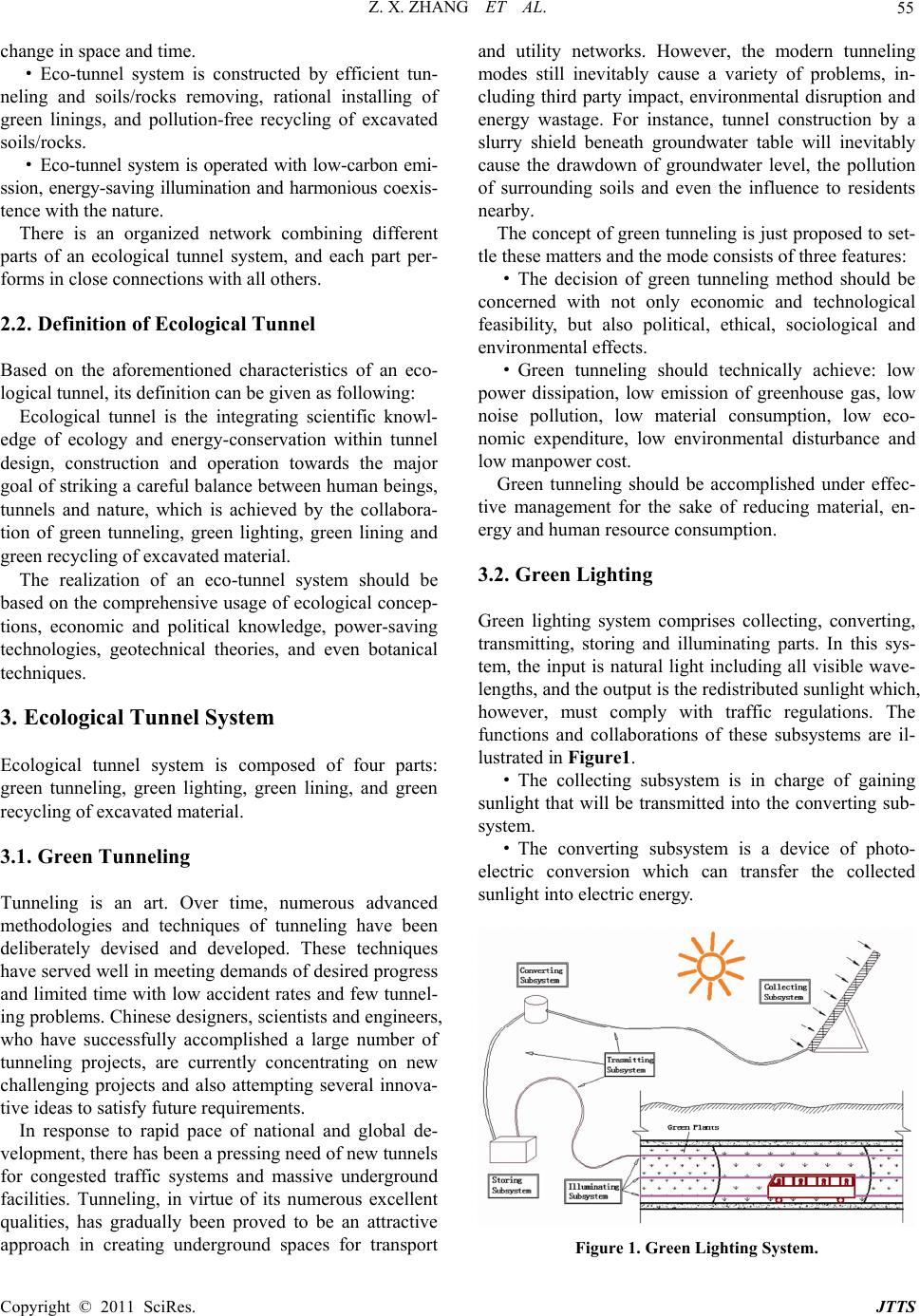
Z. X. ZHANG ET AL.
55
change in space and time.
· Eco-tunnel system is constructed by efficient tun-
neling and soils/rocks removing, rational installing of
green linings, and pollution-free recycling of excavated
soils/rocks.
· Eco-tunnel system is operated with low-carbon emi-
ssion, energy-saving illumination and harmonious coexis-
tence with the nature.
There is an organized network combining different
parts of an ecological tunnel system, and each part per-
forms in close connections with all others.
2.2. Definition of Ecological Tunnel
Based on the aforementioned characteristics of an eco-
logical tunnel, its definition can be given as following:
Ecological tunnel is the integrating scientific knowl-
edge of ecology and energy-conservation within tunnel
design, construction and operation towards the major
goal of striking a careful balance between human beings,
tunnels and nature, which is achieved by the collabora-
tion of green tunneling, green lighting, green lining and
green recycling of excavated material.
The realization of an eco-tunnel system should be
based on the comprehensive usage of ecological concep-
tions, economic and political knowledge, power-saving
technologies, geotechnical theories, and even botanical
techniques.
3. Ecological Tunnel System
Ecological tunnel system is composed of four parts:
green tunneling, green lighting, green lining, and green
recycling of excavated material.
3.1. Green Tunneling
Tunneling is an art. Over time, numerous advanced
methodologies and techniques of tunneling have been
deliberately devised and developed. These techniques
have served well in meeting demands of desired progress
and limited time with low acciden t rates and few tunnel-
ing problems. Chinese designers, scien tists and engineers,
who have successfully accomplished a large number of
tunneling projects, are currently concentrating on new
challenging projects and also attempting several innova-
tive ideas to satisfy future requirements.
In response to rapid pace of national and global de-
velopment, there has been a pressing need of new tunnels
for congested traffic systems and massive underground
facilities. Tunneling, in virtue of its numerous excellent
qualities, has gradually been proved to be an attractive
approach in creating underground spaces for transport
and utility networks. However, the modern tunneling
modes still inevitably cause a variety of problems, in-
cluding third party impact, environmental disruption and
energy wastage. For instance, tunnel construction by a
slurry shield beneath groundwater table will inevitably
cause the drawdown of groundwater level, the pollution
of surrounding soils and even the influence to residents
nearby.
The concept of g reen tunneling is just pr oposed to set-
tle these matters and the mode consists of three features:
· The decision of green tunneling method should be
concerned with not only economic and technological
feasibility, but also political, ethical, sociological and
environmental effects.
· Green tunneling should technically achieve: low
power dissipation, low emission of greenhouse gas, low
noise pollution, low material consumption, low eco-
nomic expenditure, low environmental disturbance and
low manpower cost.
Green tunneling should be accomplished under effec-
tive management for the sake of reducing material, en-
ergy and hum an re so u rce c on su mption.
3.2. Green Lighting
Green lighting system comprises collecting, converting,
transmitting, storing and illuminating parts. In this sys-
tem, the input is natural light including all visible wave-
lengths, and the output is the redistributed sunlight which,
however, must comply with traffic regulations. The
functions and collaborations of these subsystems are il-
lustrated in Figure1.
· The collecting subsystem is in charge of gaining
sunlight that will be transmitted into the converting sub-
system.
· The converting subsystem is a device of photo-
electric conversion which can transfer the collected
sunlight into electric energy.
Figure 1. Green Lighting System.
Copyright © 2011 SciRes. JTTS